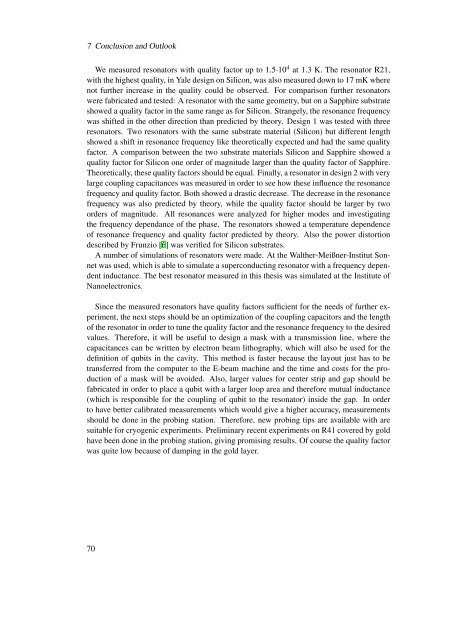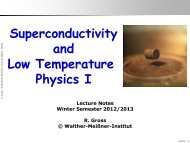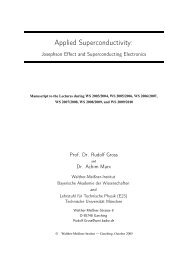Design, Fabrication and Characterization of a Microwave Resonator ...
Design, Fabrication and Characterization of a Microwave Resonator ...
Design, Fabrication and Characterization of a Microwave Resonator ...
You also want an ePaper? Increase the reach of your titles
YUMPU automatically turns print PDFs into web optimized ePapers that Google loves.
7 Conclusion <strong>and</strong> OutlookWe measured resonators with quality factor up to 1.5·10 4 at 1.3 K. The resonator R21,with the highest quality, in Yale design on Silicon, was also measured down to 17 mK wherenot further increase in the quality could be observed. For comparison further resonatorswere fabricated <strong>and</strong> tested: A resonator with the same geometry, but on a Sapphire substrateshowed a quality factor in the same range as for Silicon. Strangely, the resonance frequencywas shifted in the other direction than predicted by theory. <strong>Design</strong> 1 was tested with threeresonators. Two resonators with the same substrate material (Silicon) but different lengthshowed a shift in resonance frequency like theoretically expected <strong>and</strong> had the same qualityfactor. A comparison between the two substrate materials Silicon <strong>and</strong> Sapphire showed aquality factor for Silicon one order <strong>of</strong> magnitude larger than the quality factor <strong>of</strong> Sapphire.Theoretically, these quality factors should be equal. Finally, a resonator in design 2 with verylarge coupling capacitances was measured in order to see how these influence the resonancefrequency <strong>and</strong> quality factor. Both showed a drastic decrease. The decrease in the resonancefrequency was also predicted by theory, while the quality factor should be larger by twoorders <strong>of</strong> magnitude. All resonances were analyzed for higher modes <strong>and</strong> investigatingthe frequency dependance <strong>of</strong> the phase. The resonators showed a temperature dependence<strong>of</strong> resonance frequency <strong>and</strong> quality factor predicted by theory. Also the power distortiondescribed by Frunzio [6] was verified for Silicon substrates.A number <strong>of</strong> simulations <strong>of</strong> resonators were made. At the Walther-Meißner-Institut Sonnetwas used, which is able to simulate a superconducting resonator with a frequency dependentinductance. The best resonator measured in this thesis was simulated at the Institute <strong>of</strong>Nanoelectronics.Since the measured resonators have quality factors sufficient for the needs <strong>of</strong> further experiment,the next steps should be an optimization <strong>of</strong> the coupling capacitors <strong>and</strong> the length<strong>of</strong> the resonator in order to tune the quality factor <strong>and</strong> the resonance frequency to the desiredvalues. Therefore, it will be useful to design a mask with a transmission line, where thecapacitances can be written by electron beam lithography, which will also be used for thedefinition <strong>of</strong> qubits in the cavity. This method is faster because the layout just has to betransferred from the computer to the E-beam machine <strong>and</strong> the time <strong>and</strong> costs for the production<strong>of</strong> a mask will be avoided. Also, larger values for center strip <strong>and</strong> gap should befabricated in order to place a qubit with a larger loop area <strong>and</strong> therefore mutual inductance(which is responsible for the coupling <strong>of</strong> qubit to the resonator) inside the gap. In orderto have better calibrated measurements which would give a higher accuracy, measurementsshould be done in the probing station. Therefore, new probing tips are available with aresuitable for cryogenic experiments. Preliminary recent experiments on R41 covered by goldhave been done in the probing station, giving promising results. Of course the quality factorwas quite low because <strong>of</strong> damping in the gold layer.70
















